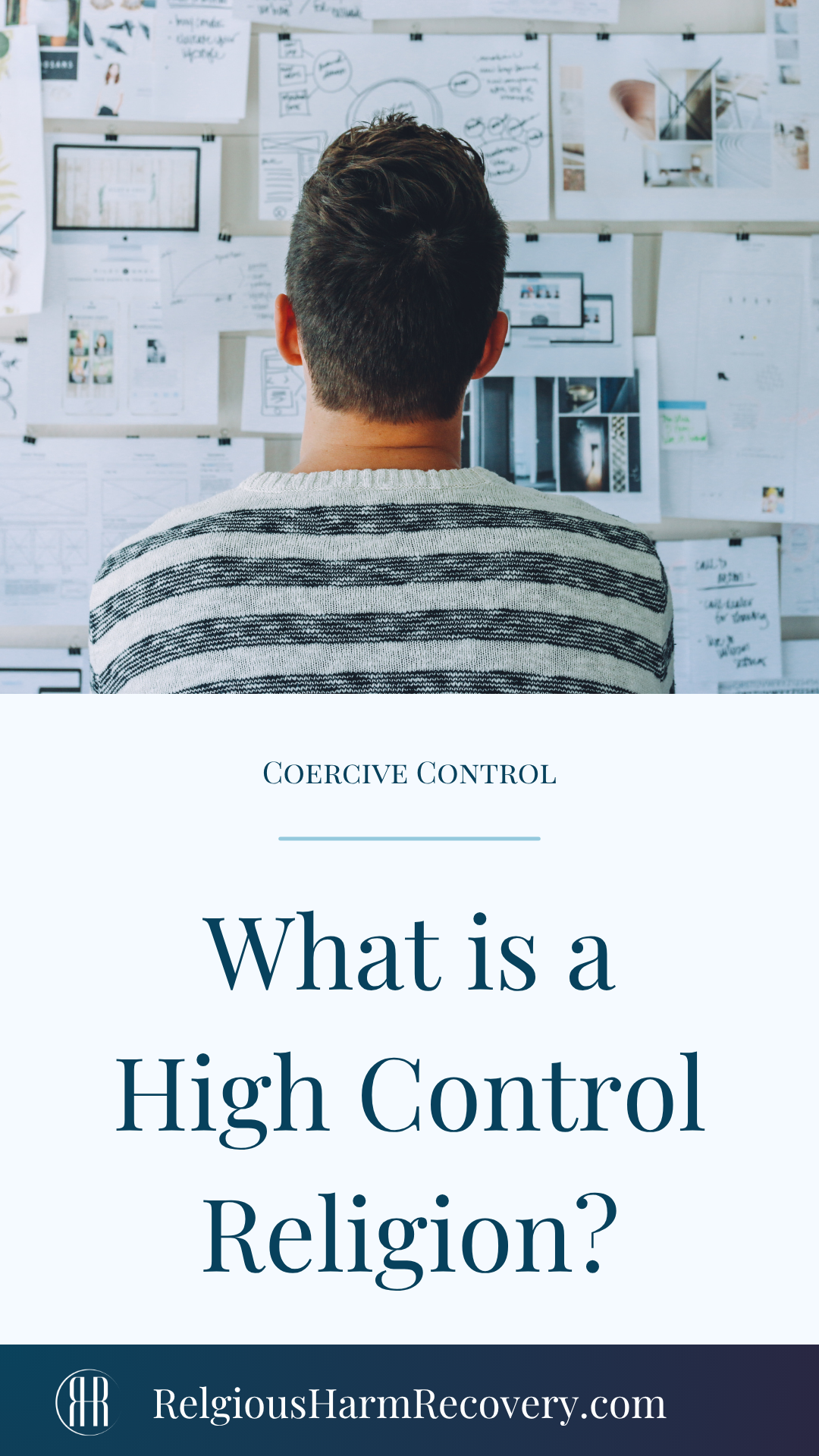What is a High Control Religion?

I first learned about the term “high control religion” from Dr. Laura Anderson who wrote When Religion Hurts You (highly recommend).
Having this terminology helps us identify religious communities that are based on power and control dynamics, which often result in negative relational, psychological, physical and/or financial outcomes for folks.
As we unpack the term high control religion, it’s important to clarify that I often use it interchangeably with religious cult because, in my opinion, high control religions meet the criteria outlined in Steven Hassan’s BITE Model—a framework for understanding how destructive groups control their members through Behavior, Information, Thought, and Emotional manipulation.
Hassan’s concept of cult can apply to any group that exercises undue influence—religious, political, or even commercial.
However, my focus here is on religious cults, since this article is discussing high control religions.
{If you’re unfamiliar with Steven Hassan’s work, I highly recommend checking it out – I’ve linked his BITE Model resource at the bottom of this article!}
What We’ll Be Covering:
What Exactly is a “Cult?”
The term “cult” often evokes images of extreme, fringe groups led by a single charismatic leader—organizations that seem far removed from mainstream religion, such as the Branch Davidians or Jonestown.
While some cults do fit that description, they exist at the far end of the influence continuum, exhibiting extreme levels of control and destructiveness.
However, because of society’s general perception of the word “cult,” many people find it jarring or alienating, as it carries significant stigma and shock value.
This is why I often use the term “high control religion” instead—it’s more descriptive and inclusive of both large religious movements and smaller, tightly controlled communities, even if these groups are technically considered cults.
The reality is that a “cult” can refer to any group—mainstream or otherwise—that exerts high levels of control over its members’ thoughts, behaviors, and relationships, even if it doesn’t reach the extreme of coercing them into “drinking the Kool-Aid.”
The Importance of Identifying High Control Religions
Not all religions or religious groups are the same in terms of the harm they cause.
While some are fairly benign (meaning not really harmful), there are many religious groups that land more on the destructive/harmful end of the spectrum.
Many people who think all religion is bad and harmful, while there are plenty of others who find that religious beliefs and rituals add meaning and value to their lives.
This article isn’t meant to debate the gap between those views.
Instead, it’s about identifying and calling out religious groups that are unequivocally destructive to the mental health, autonomy, and well-being of their members.
High control religions, without question, harm individuals and society at large.
When I use terms like high control religion, authoritarian religion, or religious cult, I am not referring to all religious groups but specifically to those that meet the criteria outlined below.
Characteristics of a High Control Religion
Here are the three overarching criteria that define a religious group as a high control religion. These are also the criteria for classifying a group as a destructive religious cult.
1. Authoritarian Leadership
High control religious groups always have an authoritarian leadership structure.
This hierarchy enforces strict obedience and limited input from members in decision-making processes.
Power flows from the top down, with leaders holding ultimate authority over doctrine, group policies, and interpretations of scripture.
What About Leaders Who Appear Humble?
It can be confusing when some church leaders seem kind and humble, portraying themselves as “god’s servant” or “god’s messenger.”
I encountered this dynamic in the fundamentalist evangelical churches I once attended.
While these leaders did not overtly take on the role of absolute authority, they placed god in that position.
This point is vital—so if you’re skimming, I encourage you to slow down here.
Churches that treat the Bible as the inerrant word of god establish god as the ultimate authoritarian leader.
God as the Absolute Authority
Churches that believe the Bible is the literal, inspired word of god view it as his direct message to humanity.
This belief creates a framework where god holds absolute authority, and the Bible is his word.
Through this lens, the religious hierarchy is established, with the leader acting as a conduit for divine guidance.
Church Leaders as Conduits of Divine Message
If you attended a church like this, you were likely encouraged to trust your pastor’s or priest’s interpretation of scripture, since they were “chosen by god” to guide the congregation.
This dynamic discourages questioning the leader’s teachings because to question them is often viewed as challenging god’s authority.
Even when a church appears non-authoritarian on the surface, a deeper look at how it treats the Bible and applies its teachings may reveal a hidden layer of authoritarianism that isn’t immediately apparent.
2. Control Over Members
The second characteristic of high control religions is coercive control over members, which manifests in several key ways:
These are outlined in Steven Hassan’s BITE Model, and we’ll explore each in more detail below.
Behavior Control
High control religions often enforce a wide array of behavioral rules that govern nearly every aspect of their members’ lives.
While some behaviors are labeled “Christ-like” or “godly,” others are considered “sinful” or morally unacceptable.
These rules can cover both major moral issues, such as prohibitions on murder or adultery, and extend into more personal areas, like dress codes, dietary restrictions, associations, and even the kinds of media members are allowed to consume.
For example, members might be told to abstain from secular entertainment, avoid certain career paths, or even restrict their social interactions to other group members.
Behavior control can also manifest through communal living arrangements, which limit personal privacy, or in financial obligations, where members are required to tithe (10% right?) or make financial sacrifices to support the group.
Non-compliance often leads to threats of punishment, which can be both spiritual (e.g., warnings of divine retribution) or social (e.g., shunning or excommunication).
By regulating members’ daily behaviors so extensively, these groups prevent individuals from developing personal autonomy, which is a hallmark of Hassan’s BITE Model under Behavior Control.
Information Control
Information control is a core element of high control religions.
These groups often restrict access to outside information, limiting members’ ability to question or challenge their teachings.
For example, members may be discouraged or outright forbidden from engaging with secular media, including books, TV shows, music, or news outlets that don’t align with the group’s beliefs.
In some cases, groups create their own literature, homeschooling curricula, and media that reinforce the group’s worldview, while discouraging members from seeking out neutral or opposing perspectives.
In high-control religious environments, leaders may also demonize outside sources of information by labeling them as “worldly” or “corrupted,” effectively shutting down any outside influence that might prompt members to “wake up” to the coercive nature of the group.
Internet use can be monitored, and members may even be encouraged to report each other for consuming or sharing non-approved information.
This isolation from external resources is a key part of the BITE Model’s Information Control and serves to keep members deeply dependent on the group for their understanding of the world.
Thought Control
High control religions pay close attention to controlling their members’ thoughts.
They encourage members to focus only on what is “pure and holy” while suppressing doubts (which they equate with a lack of faith).
Critical thinking is discouraged in favor of “childlike faith,” which is presented as a higher form of devotion.
Gaslighting is often used, convincing members that their understanding of reality is warped by sin.
This further increases their reliance on religious leaders for guidance and truth.
Emotion Control
Emotion control is a powerful tool in high control religions, often achieved through phobia indoctrination.
This involves instilling fear of divine punishment, such as eternal damnation or apocalyptic events, to keep members obedient.
Churches also manipulate emotions through music, prayer sessions, and testimonies, creating heightened emotional experiences that members attribute to the Holy Spirit, when in fact these are predictable neurochemical responses to their environment.
For more information about phobia indoctrination, check out this article: What You Need to Know About Phobia Indoctrination & Religious Cults.
3. A Rigid Belief System
High control religions promote black-and-white thinking and an us versus them mentality.
They view their beliefs as the only valid interpretation of scripture, while dismissing or demonizing other perspectives.
Black-and-White Thinking
This type of thinking leaves little room for nuance or exploration of different viewpoints.
Everything is either entirely right or completely wrong, good or evil.
This rigid mindset contributes to judgment, intolerance, and fear of questioning established beliefs, which stifles open dialogue and critical thinking.
Us vs. Them Mentality
Many authoritarian religious groups foster an “us versus them” mentality, creating a clear divide between insiders and outsiders.
Outsiders are often seen as inferior, lost, or even dangerous.
This mindset encourages group members to isolate themselves from mainstream society, further entrenching their commitment to the group.
It also makes it harder for members to leave, as doing so feels like turning their backs on a righteous “us” to join a threatening “them.”
A Broader Perspective on Religion
“Low Control” Religious Groups
Someone once asked me to give an example of a low control religion, and I think it’s a helpful way to highlight the contrast between healthy spiritual communities and high control groups.
Low control or non-controlling religions typically allow for greater personal autonomy and flexibility in how members engage with religious texts, rituals, and leadership.
For instance, many progressive Christian communities encourage members to interpret the Bible in ways that resonate with their personal values and life experiences.
Similarly, Unitarian Universalism is a religious tradition that embraces diversity of belief, allowing individuals to draw from various spiritual and philosophical traditions without imposing strict dogma.
In these low-control environments, members are free to leave without fear of punishment or ostracism, and questioning or exploring different viewpoints is not only tolerated but encouraged.
These communities promote inclusivity and tolerance for differences, both within the group and in society at large.
Cultural Considerations
When many people think about religion, especially in the context of high control or authoritarian groups, they often focus on Western forms, particularly those with roots in Catholicism or Protestantism.
And, while it’s true that many of these groups exhibit controlling and rigid behaviors, it’s important to remember that there are numerous other religious traditions worldwide, some of which may not meet the criteria for a high control religion.
For example, indigenous spiritual traditions, Eastern philosophies like Buddhism or Taoism, and certain progressive Christian denominations seem more likely to encourage individual autonomy and personal spiritual exploration.
These groups typically do not impose strict rules or punishments for non-compliance, and they often promote inclusivity and flexibility in belief systems.
In these traditions, there is room for critical thinking, questioning, and personal growth, which contrasts sharply with the rigid, authoritarian structures found in high control religions.
Religious groups that exist outside of Catholicism and Protestantism should not be overlooked in conversations about the impacts of religion.
By expanding our perspective to include non-Western spiritual practices, we can gain a more nuanced understanding of both harmful and healthy religious environments.
Stephen Hassan’s BITE Model:
As promised, here is the link to Stephen Hassan’s BITE model to help you determine whether a group is somewhere on the “cult spectrum.”
Some Possible Next Steps:
If this article resonated with you and you’re looking to go deeper, here are a few things that may help.
Other Articles About Coercive Control:
-
How Loyalty to a Narcissistic God Damages Mental Health
It’s common knowledge that narcissists can take a real toll on the mental health of those they’re close to, but have you considered that perhaps the god you once served was a narcissist?
-
Understanding Religious Cult Programming + How to Recover
This article provides a detailed overview of how religious cults use programming techniques to control their members, and it also breaks down some effective strategies for deprogramming and recovery.
-
7 Subtle Signs of Spiritual Abuse
When I first began to deconstruct my faith, I struggled to make sense of my experiences. I struggled because nothing in my religious past seemed to fit the conventional idea of trauma or abuse. I hadn’t been physically or verbally…


